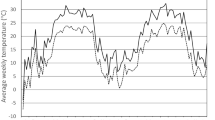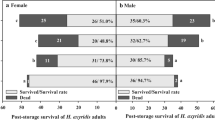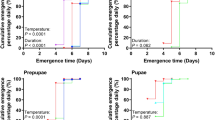Abstract
Laboratory colonies are necessary to conduct year-round research on the invasive brown marmorated stink bug, Halyomorpha halys (Stål), a severe agricultural and nuisance pest in the USA. When adults are collected in the fall to either start or supplement colonies, they require a period of cold storage before they resume sexual development and egg production. There is a lack of understanding of how to collect and store diapause-triggered adults in the laboratory. A series of experiments in 2013–2015 assessed survival and fecundity of stink bugs collected from different locations and stored under different temperatures and durations. We found that a minimum of 7 weeks is necessary to break diapause and that a substantial proportion of adults can survive when stored at constant 9 °C, even for periods longer than needed to terminate diapause. Adults survived significantly better at 6 and 9 °C than at 3 °C in storage for 7 weeks. Longer durations up to 34 weeks in storage reduced adult survival and significantly affected survival rates, timing of first egg laying, and overall fecundity. Location where adults were collected at overwintering sites in the fall had a significant impact on survival in cold storage and colony performance. Adults collected from soybean fields in mid-September and fed in the laboratory for 2 weeks before storage had lower survival than adults collected in October at aggregation sites and stored immediately. The food sources available to H. halys adults at collection locations for nutrition and sequestration of sufficient energy reserves going into diapause are discussed.





Similar content being viewed by others
References
Acebes-Doria AL, Leskey TC, Bergh JC (2016) Host plant effects on Halyomorpha halys (Hemiptera: Pentatomidae) nymphal development and survivorship. Environ Entomol 45:663–670
Bergmann EJ, Venugopal DP, Martinson HM, Raupp MJ, Shrewsbury PM (2016) Host plant use by the invasive Halyomorpha halys (Stål) on woody ornamental trees and shrubs. PLoS ONE 11(2):e0149975
Bloem S (1997) Mass-rearing and storing codling moth larvae in diapause: a novel approach to increase production for sterile insect release. J Entomol Soc Brit Columbia 94:75–81
Cira TM, Venette RC, Aigner J, Kuhar T, Mullins DE, Gabbert SE, Hutchison WD (2016) Cold tolerance of Halyomorpha halys (Hemiptera: Pentatomidae) across geographic and temporal scales. Environ Entomol 45(2):484–491
Davis FM (1983) Simple technique for storing diapausing southwestern corn borers (Lepidoptera: Pyralidae). J Econ Entomol 76:1191–1192
Dingha B, Jackai L (2017) Laboratory rearing of the brown marmorated stink bug (Hemiptera: Pentatomidae) and the impact of single and combination of food substrates on development and survival. Can Entomol 149(1):104–117
Hahn DA, Delinger DL (2007) Meeting the energetic demands of insect diapause: nutrition storage and utilization. J Insect Physiol 53:760–773
Hahn DA, Denlinger DL (2011) Energetics of diapause. Ann Rev Entomol 56:103–121
Hoebeke ER, Carter ME (2003) Halyomorpha halys (Stål) (Heteroptera: Pentatomidae): a polyphagous plant pest from Asia newly detected in North America. Proc Entomol Soc Wash 105(1):225–237
Kiritani K (2007) The impact of global warming and land-use change on the pest status of rice and fruit bugs (Heteroptera) in Japan. Glob Change Biol 13:1586–1595
Lee DH, Short BD, Joseph SV et al (2013) Review of the biology, ecology, and management of Halyomorpha halys in China, Japan, and the Republic of Korea. Environ Entomol 42(4):627–641
Leopold RA (2007) Colony maintenance and mass-rearing: using cold storage technology for extending the shelf-life of insects. In: Vreysen MJB, Robinson AS, Hendrichs J (eds) Area-wide control of insects: from research to field implementation. Springer, Dordrecht, pp 149–162
Leskey TC, Hamilton GC, Nielsen AL, Polk DF, Rodriguez-Saona C et al (2012a) Pest status of the brown marmorated stink bug, Halyomorpha halys in the USA. Outlooks Pest Manag 23(5):218–226
Leskey TC, Short BD, Butler BR, Wright SE (2012b) Impact of the invasive brown marmorated stink bug, Halyomorpha halys (Stål), in mid–Atlantic tree fruit orchards in the United States: case studies of commercial management. Psyche J Entomol 2012:1–14
Li X, Yin XY, Li M, Liu YH, Fu J, Liu XF (2007) Halyomorpha halys behaviors and their application for control. J Northwest A F Univ 35:139–145
Medal J, Smith T, Fox A, Cruz AS, Poplin A, Hodges A (2012) Rearing the brown marmorated stink bug Halyomorpha halys (Heteroptera: Pentatomidae). Florida Entomol 95:800–802
Nielsen AL, Hamilton GC (2009) Seasonal occurrence and impact of Halyomorpha halys (Hemiptera: Pentatomidae) in tree fruit. J Econ Entomol 102:113–1140
Niva CC, Takeda M (2002) Color changes in Halyomorpha halys (Heteroptera: Pentatomidae) correlated with distribution of pteridines: regulation by environmental and physiological factors. Compos Biochem Physiol B 132:653–660
Niva CC, Takeda M (2003) Effects of photoperiod, temperature and melatonin on nymphal development, polyphenism and reproduction in Halyomorpha halys (Heteroptera: Pentatomidae). Zool Sci 20:963–970
Rosen SJ, Cambridge JE, Hamilton GC (2016) Rearing protocols and density trials of the brown marmorated stink bug (Hemiptera: Pentatomidae) in the laboratory. Florida Entomol 99(4):808–810
SAS (2013) The SAS system, release 9.4. SAS Institute Inc., Cary
Saulich AK, Musolin DL (2012) Diapause in the seasonal cycle of stink bugs (Heteroptera, Pentatomidae) from the temperate zone. Entomol Rev 92(1):1–26
StopBMSB.org: Where Is BMSB: state-by-state, Northeastern IPM center. http://www.stopbmsb.org/where-is-bmsb/state-by-state/. Accessed 18 Jan 2017
Venugopal PD, Coffey PL, Dively GP, Lamp WO (2014) Adjacent habitat influence on stink bug (Hemiptera: Pentatomidae) densities and the associated damage at field corn and soybean edges. PLoS ONE 9(10):e109917
Watanabe M (1979) Ecology and extermination of Halyomorpha halys. 4. The relationship between day length and ovarian development. Ann Rep Toyama Inst Health 3:33–37
Watanabe M, Arakawa R, Sinagawa Y, Okazawa T (1994) Overwintering flight of brown-marmorated stink bug, Halyomorpha mista to the buildings. Jpn J Sanitary ZooI 45:25–31
Acknowledgements
We thank Terry Patton, Jesse Ditillo, Jesse Saunders, Jake Bodart, Emily Zobel, Veronica Johnson, Erin Norcross, Matt Dimock, and Taylor Shulden for their assistance with the tedious tasks of collecting, sorting, and maintaining the thousands of H. halys adults needed for these studies. This work was funded by the US Department of Agriculture—National Institute of Food and Agriculture Specialty Crop Research Initiative (SCRI) #2011-51181-30937: Biology, Ecology, and Management of Brown Marmorated Stink Bug in Orchard Crops, Small Fruit, Grapes, Vegetables and Ornamentals. The funders had no role in study design, data collection and analysis, decision to publish, or preparation of the manuscript.
Author information
Authors and Affiliations
Corresponding author
Ethics declarations
Conflict of interest
The authors declare that they have no conflict of interest.
Additional information
Communicated by T. Haye.
Special Issue: The brown marmorated stink bug Halyomorpha halys an emerging pest of global concern.
Rights and permissions
About this article
Cite this article
Taylor, C.M., Coffey, P.L., Hamby, K.A. et al. Laboratory rearing of Halyomorpha halys: methods to optimize survival and fitness of adults during and after diapause. J Pest Sci 90, 1069–1077 (2017). https://doi.org/10.1007/s10340-017-0881-9
Received:
Revised:
Accepted:
Published:
Issue Date:
DOI: https://doi.org/10.1007/s10340-017-0881-9




